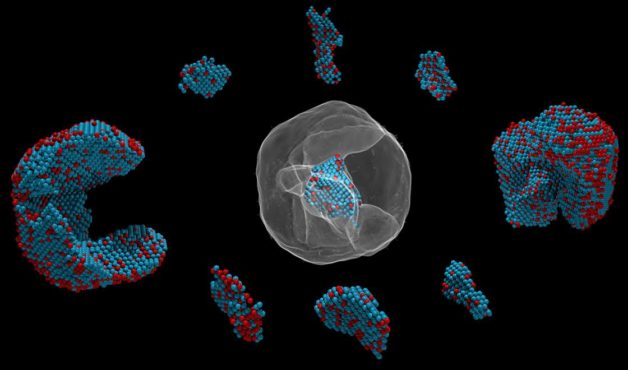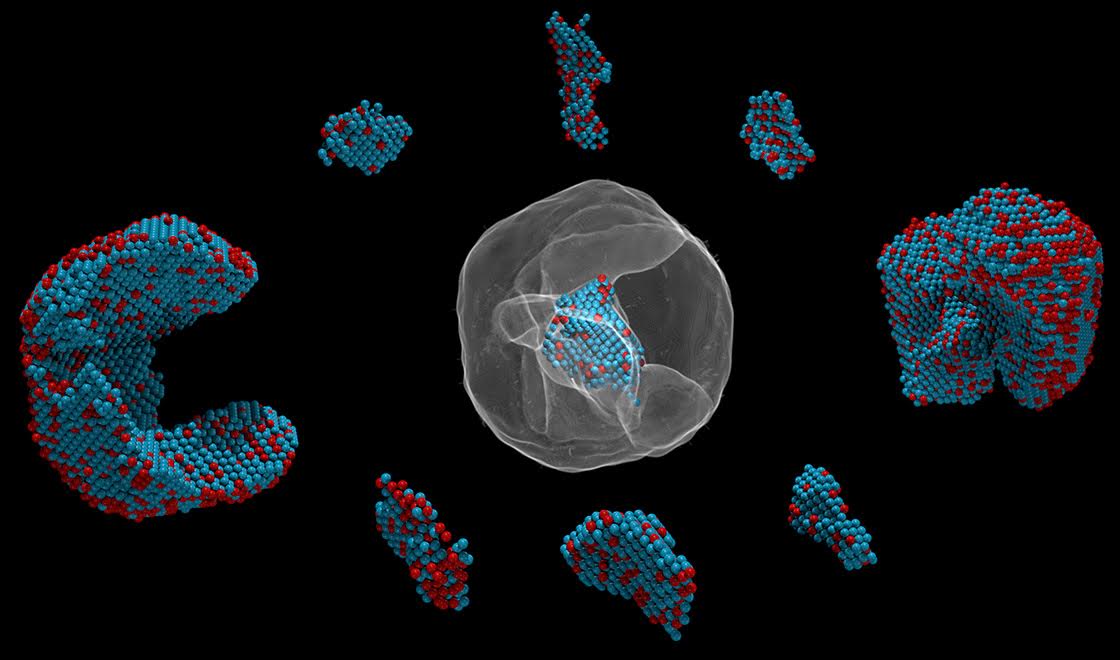
This image shows the atomic composition of an iron-platinum nanoparticle, split into separate parts that show the position of individual atoms. (Credit: Colin Ophus and Florian Niekiel/Berkeley Lab)
–By Lauren Chong
Mapping the internal atomic structure of small particles just got easier thanks to a new computer algorithm and graphical user interface (GUI) developed by scientists at and Lawrence Berkeley National Laboratory (Berkeley Lab) and University of California, Los Angeles.
The advancement brings a new tool to the field of electron tomography that the researchers hope will expand the usefulness of the techniques they use to assemble detailed 3-D images of objects by scanning them with a beam of electrons. Tomography allows researchers to look inside a material and study its internal structure, like with X-rays and MRIs (magnetic resonance imaging scans) in medical science. Atomic electron tomography (AET) has become increasingly important for precisely characterizing a wide range of materials at the single-atom level.
“Unlike biological structures, in materials science every nanoparticle’s structure is unique – like a snowflake – at the atomic scale,” said Peter Ercius, staff scientist at the National Center for Electron Microscopy, a facility at Berkeley Lab’s Molecular Foundry. “With the 3-D coordinates, you can start learning about the precise atomic structure and how that structure gives a material its properties.” The Molecular Foundry is a nanoscale scientific research center that is open to visiting scientists from around the nation and world.
To map a structure in 3-D, scientists image the particle in 2-D from multiple angles and then rely on sophisticated computer algorithms to convert the series of 2-D projections into a 3-D reconstruction of the particle. The research team previously reported on mapping the 3-D coordinates of more than 3,000 atoms in a tungsten needle to a precision of 19 trillionths of a meter (19 picometers), and 23,000 atoms in a platinum-iron nanoparticle, along with distinguishing between different elements within that same particle.

A newly developed graphical user interface makes it easier for researchers to take advantage of computer algorithms designed for atomic electron tomography. (Berkeley Lab)
The researchers’ new computer algorithm is parallelized, meaning that its individual tasks can be split and run simultaneously on separate computer processors. The separate outcomes are then combined to produce the final result. This capability greatly increases the image-processing speed.
They also hope to increase the accessibility of their technique by making the code open source, and having a GUI that is easy to use. “The user interface will provide a way to set up the calculations and analyze the results while showing all of the options available, so users can optimize their image reconstructions,” Ercius said. “Every nanostructure is unique and requires input from the user to get the best results.”
To help make AET more accessible and widely used, in October the Molecular Foundry will host a four-day event featuring a two-day workshop and two-day short course, “Frontiers in Electron Tomography,” that will feature discussions and hands-on training for these new techniques. Registration for the event ends September 15.
For more information about Atomic Electron Tomography: http://newscenter.lbl.gov/2017/02/01/nanoparticle/
